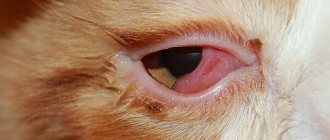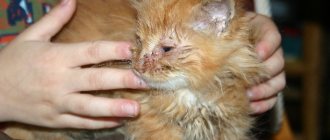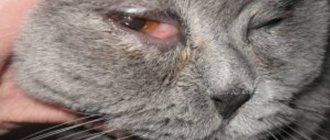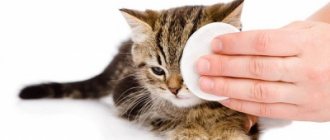Inflammatory eye diseases
develop as a result of a specific reaction of the body to damage or the introduction of a foreign agent, and constitute the main part of all ophthalmological pathology. If left untreated, these diseases can lead to serious complications: clouding of the cornea, decreased vision, and spread of the process to adjacent tissues and organs.
The inflammatory process can occur in any part of the eyeball: cornea, conjunctiva, sclera, iris, choroid. Most often in the practice of an ophthalmologist, pathology of the anterior part of the eye occurs.
Conjunctivitis
The conjunctiva is the outer membrane covering the eyeball and eyelids, which is the first to come into contact with harmful environmental influences. Therefore, conjunctivitis accounts for 60% of all inflammatory diseases.
According to the course, acute and chronic variants of the disease are distinguished. Main symptoms of eye diseases
in the acute stage: redness of the conjunctiva, intense lacrimation, a feeling of “sand in the eyes,” intolerance to bright light, pain and burning. In the chronic form, bilateral inflammation always develops.
Keratitis
This disease occurs when the cornea (the transparent membrane at the front of the eye) is damaged. A distinctive feature of the pathology is a sharp decrease in the size of the palpebral fissure up to complete closure of the eyelids, which occurs due to irritation of nerve receptors. Other signs: increased sensitivity to light, lacrimation, intense pain, foreign body sensation. With a long course of the disease, ulceration of the cornea is observed.
Barley (hordeolum)
The disease is an acute inflammation of the sebaceous gland or hair follicle of the eyelid. The pathology has a characteristic clinical picture: first there is swelling and redness of the eyelid area, which may be accompanied by itching, burning, and a sensation of a foreign body. After a few days, the swelling thickens and a yellow dot appears in its center, which indicates the maturation of the abscess. Then the barley is opened with the release of pus. In severe cases of the disease, an extensive abscess forms with a tendency to spread to surrounding tissues.
Blepharitis
This eye disease is characterized by chronic inflammation of the edges of the eyelids of various etiologies. Local symptoms of the pathology: hyperemia and swelling of the eyelids, pain and burning in the eyeball, decreased clarity of vision. There may also be mucous or purulent discharge, which leads to sticking of the eyelids and the inability to open the eyes. With scaly blepharitis, intense fine-plate peeling of the skin of the eyelid is noted. With ulcerative blepharitis, superficial skin defects are formed, accompanied by inflammation of the hair follicles of the eyelashes.
Uveitis
Depending on the location of the lesion, anterior uveitis (iridocyclitis) and posterior uveitis (chorioretinitis) are distinguished. With iridocyclitis, pain and burning, intense lacrimation, redness, and decreased visual acuity are noted. Chorioretinitis is characterized by scant clinical symptoms. The disease occurs in a chronic form, the first signs are dull pain inside the eyeball, “fog” before the eyes, distortion of the shape of surrounding objects. Without treatment, the disease can result in complete loss of vision.
How to examine a cat?
Quite often, the appearance of tears in a cat's eyes indicates the presence of some kind of disease. It is important for the owner to pay attention to whether tears appeared for a limited time and then disappeared, or in the pet’s eyes the discharge is present throughout the day, or, what is much worse, not for several days.
- If the tear discharge is insignificant, appeared in the morning and quickly passed, then there is nothing to worry about, so there is no need to worry;
- If it is clear that the eyes “cry” for a long time, then you need to look for the cause of this phenomenon.
Before examining your pet, you need to clean your hands to prevent additional infection. Next, you need to pull down the upper eyelids on each eye. If the eyes are shiny and not clouded, the pupils are the same size, the cornea is noticeably transparent, and the back surface of both eyelids has a pale pink tint, then there are no problems with the animal’s eyes.
The fact that there are certain problems with the eyes can be judged by redness or swelling of the eyelids, clouding of the cornea.
If the animal’s eyes are difficult to open or there is a thin light film on the inner surface of the eyelid, then it is recommended to go to the veterinarian as soon as possible.
Causes and treatment
There are several common reasons why a cat's eyes may start to water.
Some foreign body has entered the eye. It could be a speck, a twig, a fluff, a midge or dirt. If something like this is discovered, you must first rinse the pet’s eyes under running water. Once the foreign object is washed away, you can use one percent tetracycline ointment to apply to the cat's upper eyelid area. It is recommended to take the animal to a veterinarian for consultation.
The pet has a weakened immune system. This happens if the kitten was separated from its mother too early. However, only a veterinarian can reliably determine whether this is the case. He will also develop a regimen for taking the required medications and correct the pet’s nutrition.
The presence of an allergic reaction, which is inherent in cats as well as in humans. The same thing that can act as an allergen can act as a human allergen: chemicals, dust, pollen, etc. In this case, it is imperative to contact a qualified specialist for consultation, since the owner will not be able to independently determine not only the allergy itself, but also the cause of its occurrence.
Worms are a fairly common reason why a cat's eyes may begin to water. To exclude this, it is necessary to regularly treat the animal for parasites.
Pet breed. Some cat breeds have a characteristic skull structure with deformed nasolacrimal ducts and a flattened nose. In this case, only washing the eyes every day helps, as well as special attention to hygiene procedures in such a risky area.
Diseases of cold origin. If your pet coughs and sneezes additionally, absorbs a lot of water, and begins to sleep much more, then it is quite possible to suspect a cold. It is not recommended to treat the animal yourself; you need to contact a specialized specialist.
Cat distemper also has discharge from the eyes as one of its symptoms. In addition, the appearance of pus, high fever, vomiting and diarrhea, and general weakness are noted. It is not allowed to treat a pet with such symptoms on your own.
It is important to know
The decision of how and with what means to wash a cat’s eyes depends on the specific case. It is necessary to take into account the reason for which it was necessary to clean the eyes, as well as the individual reaction to any component in the composition of the drug.
If lacrimation is excessive
You can rinse your eyes with clean distilled water, but it is better with saline solution (with a salt concentration of 0.85%). This procedure will also help in removing dust, pollen, hairs and other small foreign bodies. If your pet has allergies, this method is the best.
If your eyes fester
In case of purulent exudate from the eyes or their sticking together (this happens after a while, when dry crusts appear), you need to drip the eyes with special antibacterial drugs, which are purchased at a veterinary pharmacy. This is necessary because pus is a symptom of infection.
Chlorhexidine for eye rinsing
Veterinarians do not agree on this issue, but the majority believes that it is possible. But you need to use chlorgesidine with a concentration of no more than 0.01%, then the use will be harmless.
Cleansing with furatsilin
Furacilin solution must be used with a concentration of maximum 0.02%, and the drug must also be sterile
It is important to know about possible individual intolerance to the substance; if it exists, then the use of furatsilin is prohibited
Eye diseases accompanied by the production of tears
There are several different eye conditions in pets that cause tear production:
- Infection. If the eye is noticeably swollen and red, and there is discharge of pus, then the help of a veterinarian is definitely needed to prevent the development of feline conjunctivitis.
- Directly eye diseases, in particular glaucoma or cataracts. A clouded cornea in the first case or a whitened lens in the second are the most obvious symptoms of these diseases. Of course, you definitely need to go to a clinic for treatment.
- Diseases caused by fungi or viruses (such as toxoplasmosis or chlamydia) can only be cured by a veterinarian.
- Inflammation of the cornea can be identified by reddened and very watery eyes, on which a soapy film forms.
- Some breeds experience entropion of the eyelid - usually Sphynxes or Persians. The appearance of swollen eyes and suppuration in their eyes is a reason to visit a veterinarian as soon as possible.
- Eye injuries that a cat can get if it fights with its fellow tribesmen, hits itself, or gets caught on some branches. Wounds or other damage to the eyeballs are obvious symptoms of this injury. It is recommended to consult a veterinarian to determine the severity of the damage.
Table of contents:
Causes of tearing Classification Symptoms and diagnosis Treatment of tearing eyes Prevention
Tearing is a natural process. The fluid secreted by the tear glands moisturizes the surface of the eye and protects the mucous membrane from dust and other particles. Excessive lacrimation occurs during inflammatory processes. It signals the development of ophthalmopathology. Treatment of tearing eyes should be carried out under the supervision of a doctor, since if treated incorrectly, the infection can lead to suppuration and deterioration of vision.
The color of the discharge from the eyes matters
It is important for the pet owner to carefully look at the color of the discharge coming from the eyes.
If they are transparent, similar to ordinary tears, then this may be due to the characteristics of the breed, mechanical irritation, or the occurrence of an allergic reaction.
If yellow or green discharge appears, in which pus is present, we can say that there is an infectious disease.
If a cat's eyes are watery red or brown, then there is a high probability that the cat is infected with worms.
When to contact a veterinarian
Examine the cat carefully. If the tears are clean and transparent, without any admixture of pus or blood, there are no signs of swelling, and the cat plays with pleasure and has an excellent appetite, there is nothing to worry about. Your pet does not require treatment, but only proper care.
A visit to the veterinarian is required if the following signs are detected:
- The cat doesn't eat well.
- Her snot is flowing.
- He often scratches his eyes.
- Cloudy or purulent tears.
- Dull eyes.
- The cat is too excited or, conversely, too lethargic.
- The cat's eye is swollen.
- There are deep scratches and cuts around the eyes.
In specialized veterinary clinics they will always be able to accurately determine the diagnosis and correctly state the cause of watery cat eyes.
The Scottish Fold cat's eyes are watery: why?
It was previously mentioned that certain breeds of pets have a non-standard nasolacrimal duct, and among them the British, Scottish and Persian breeds stand out. Due to such features, the lacrimal canal is not able to fully remove secretions, which are the norm for all other breeds. In this case, the excess comes out through the eyes. If this happens after the animal has slept, then there is no reason to worry. This phenomenon is normal from a physiological standpoint.
If your pet constantly produces tears, this is no longer considered normal, so you need to seek the help of a veterinarian to find out the reasons.
Such animals need to wash their eyes once a week or more often, and in some cases up to 2-3 times a day. With a normal level of discharge, it is quite enough to simply wipe them periodically.
If your cat's eyes often water, it is recommended to bring the animal to the veterinarian for a full examination.
The cat is shedding tears. What to do?
Dog Who do you have? Tell us about your pet and get access to free consultations and advice! Cat
In order to properly treat constant excessive tearing in a cat, you need to make a correct diagnosis. This is impossible at home, so if you notice that your cat’s eye is regularly watering, you should immediately contact a veterinary clinic.
The veterinarian should examine the eyes for injuries or foreign bodies. For infectious diseases, the doctor prescribes antibacterial drugs depending on the type of pathogen. If a foreign body gets into the cat's eye, the veterinarian will remove it with a cotton swab or tweezers and then inject a numbing drug into the eye.
Cat protection
A very correct approach is the use of hygienic methods that protect the animal from the need for treatment in the future. It is recommended to periodically wash your pet's eyes with a cotton swab dipped in warm water towards the spout.
If there is dried discharge on the eyes, then you need to carefully soften and remove it, and then rinse the eyes with a clean swab.
You cannot use the same swab to treat both eyes; you need to take a new one each time.
If your pet has watery eyes, you do not need to buy and apply drops or medications yourself without consulting a veterinarian, as this can make the animal sick.
Preventive procedures
If there is no obvious problem at the moment, you can use the recommendations for prevention. A warm decoction of medicinal plants, which are also intended for humans, drops that do not contain an antibiotic, or green tea are suitable for this.
If your cat's eyes are watery due to an infectious disease confirmed by a veterinarian, then tetracycline ointment can be used.
To treat bacterial infections, “Diamond Eyes” drops or some of their analogues are used.
Main symptoms
There are many nerve receptors on the surface of the cornea, which is why the slightest impact on it is accompanied by severe discomfort. This protective reaction helps reduce the duration of traumatic contacts and protects against penetrating damage to the cornea.
Characteristic symptoms of injuries and damage to the outer shell of the eye are:
- intense lacrimation;
- intolerance to bright light;
- blepharospasm (uncontrolled tension of the eyelid muscles);
- pain that feels like sand in the eyes;
- partial loss of vision, inability to focus;
- redness of the mucous membranes of the eyelids, the appearance of a vascular pattern on the sclera.
With deep penetrating wounds of the eyes, when the destructive process affects the optic nerves, the clinical picture is complemented by intense headache, nausea, and dizziness.











